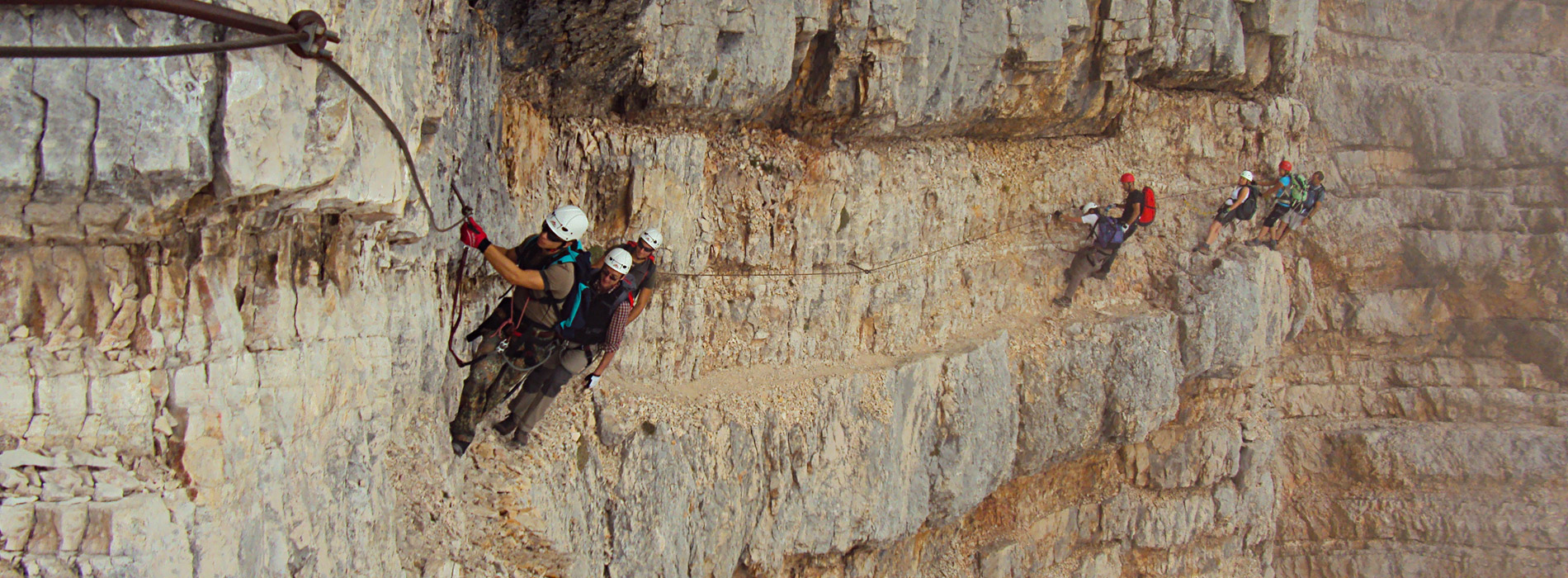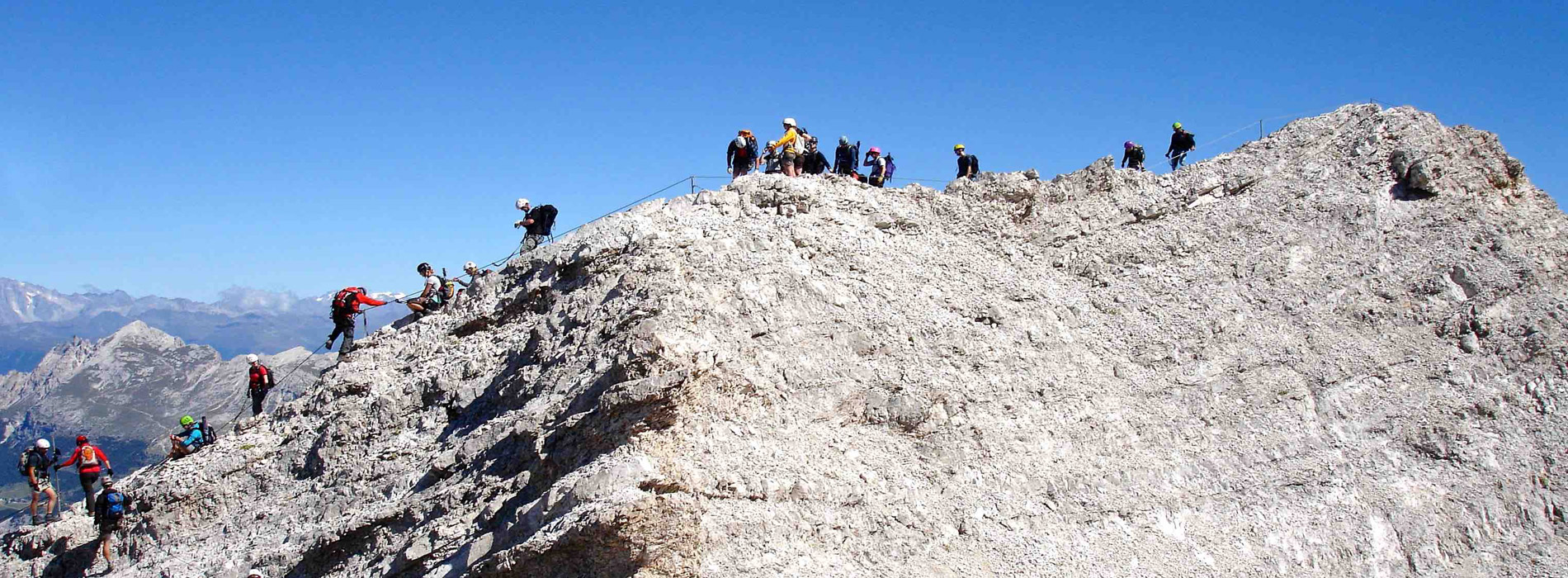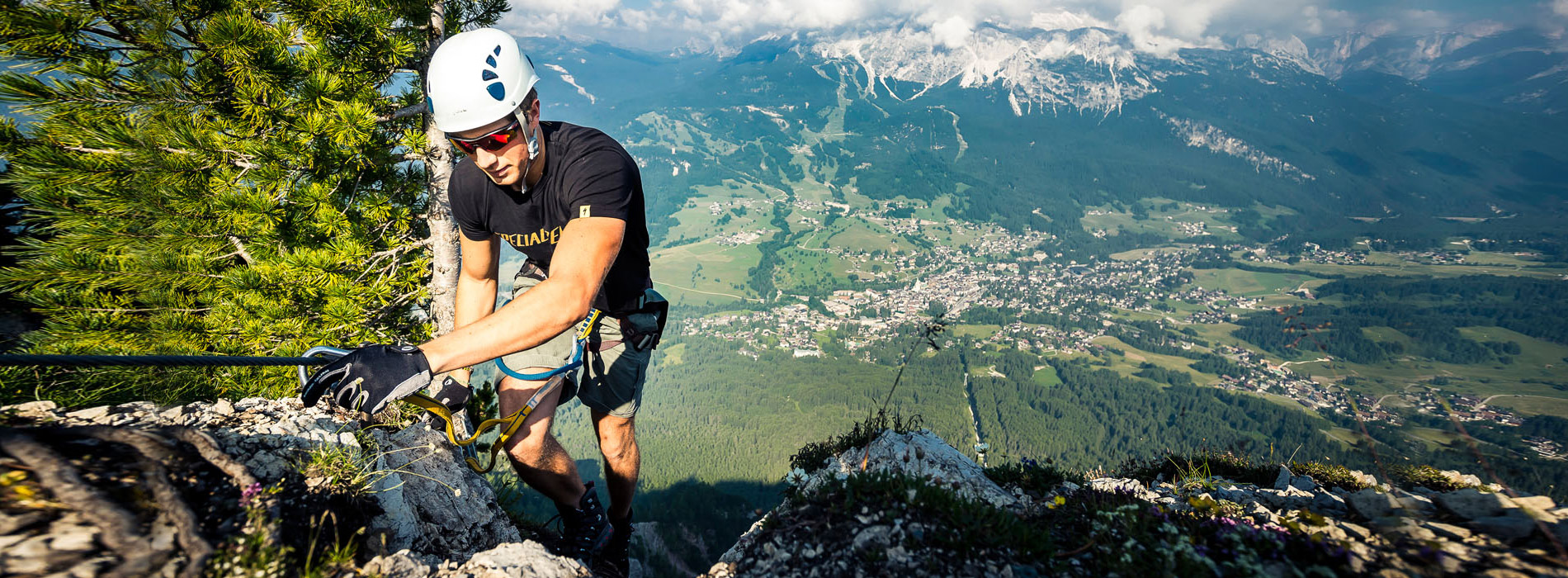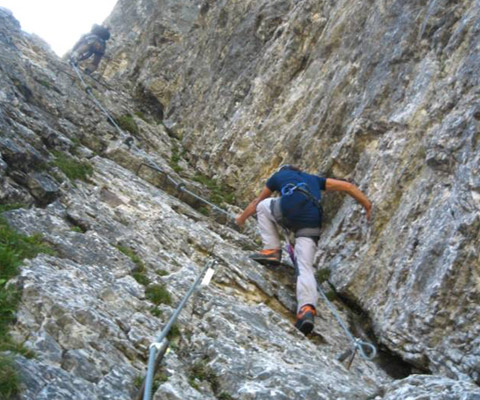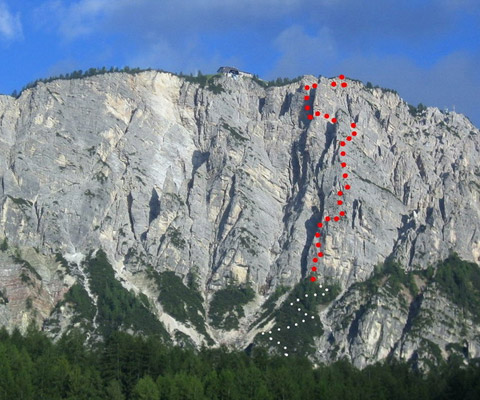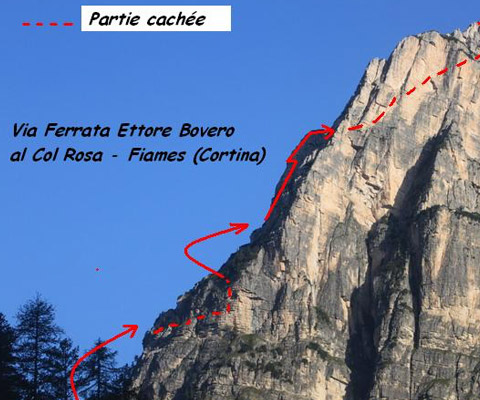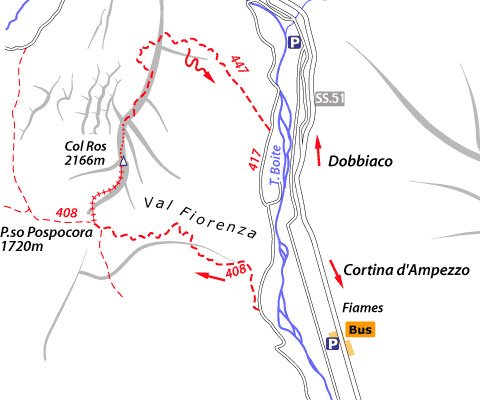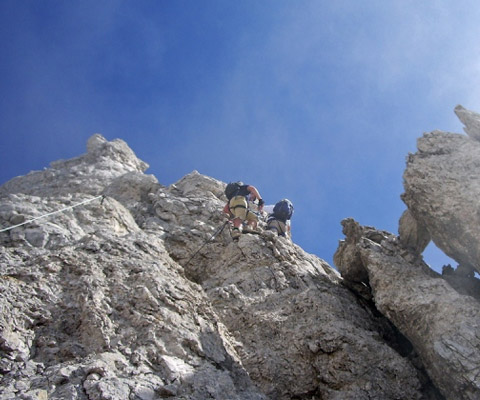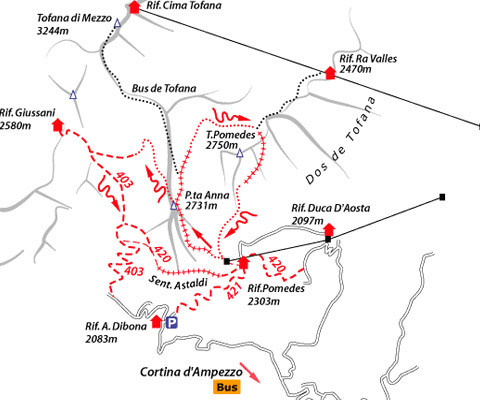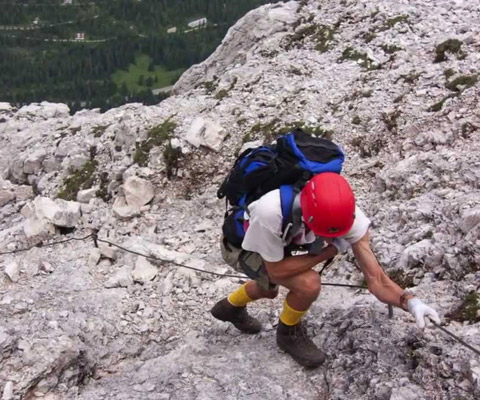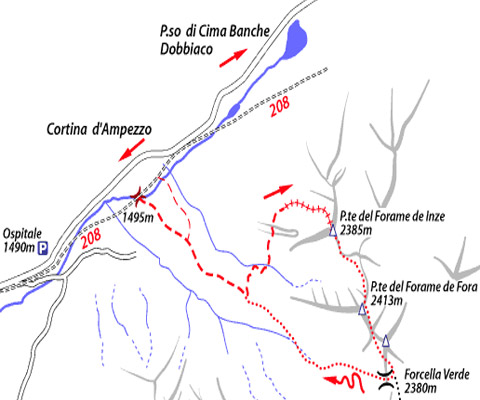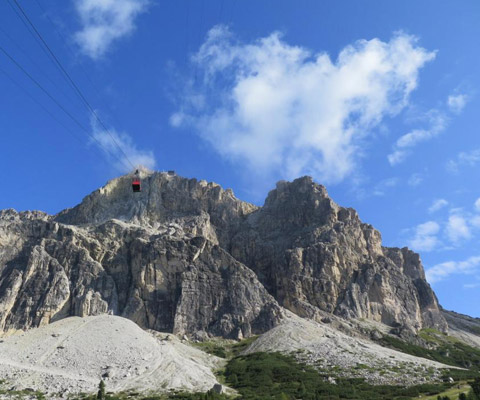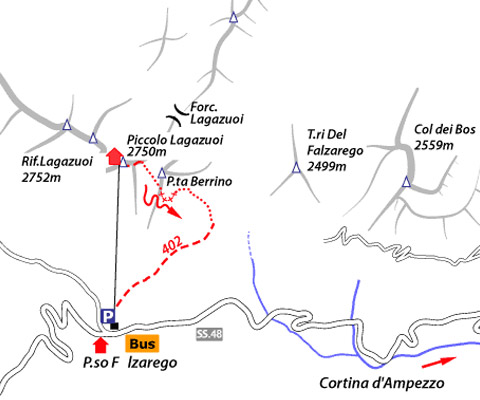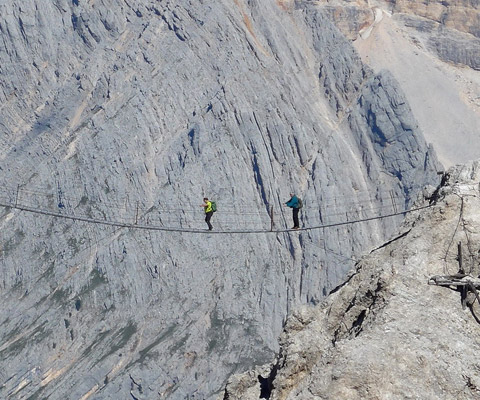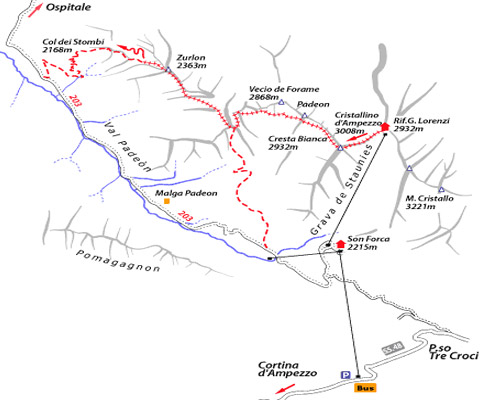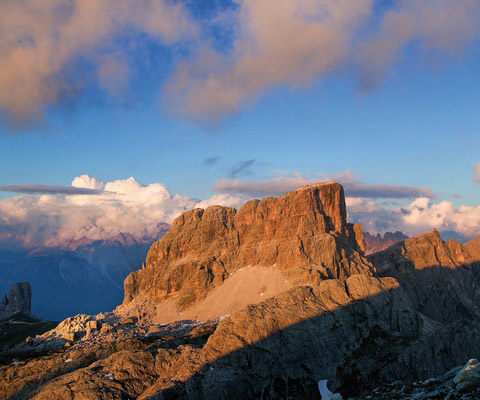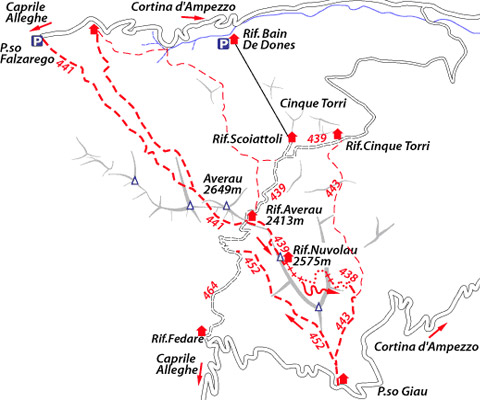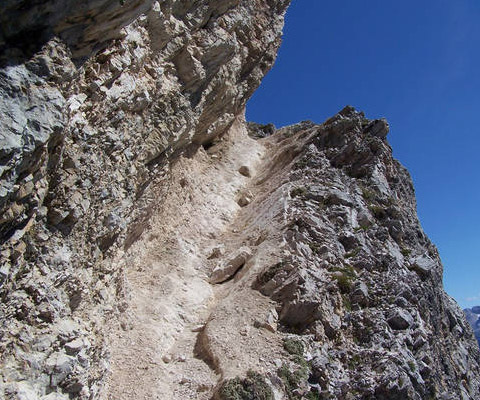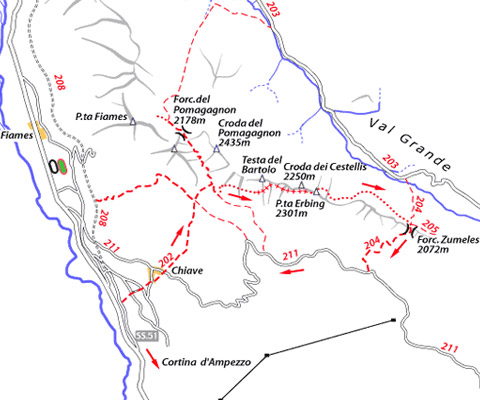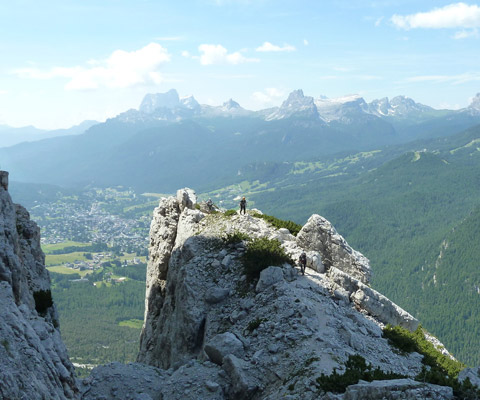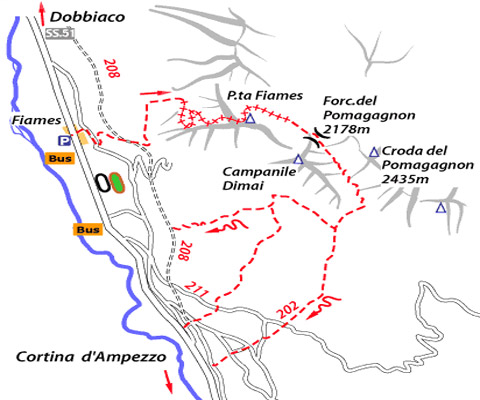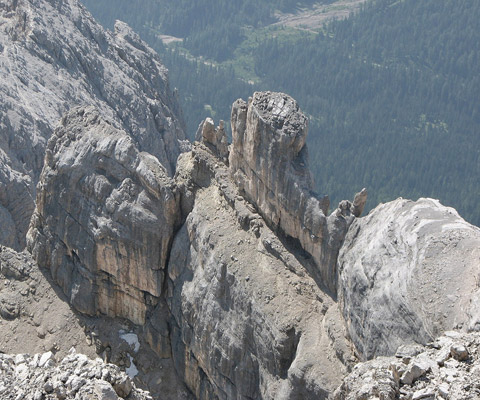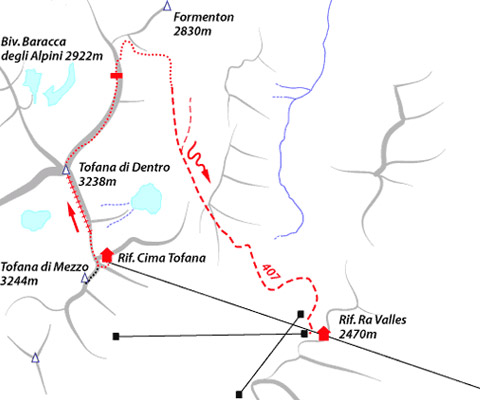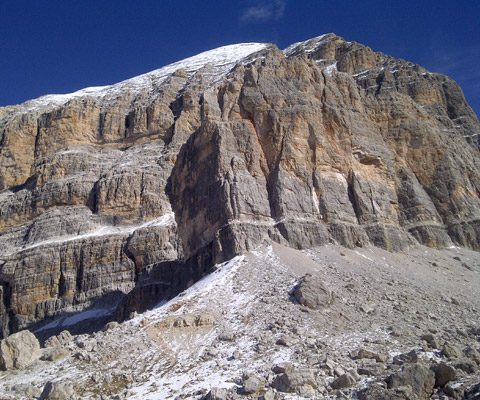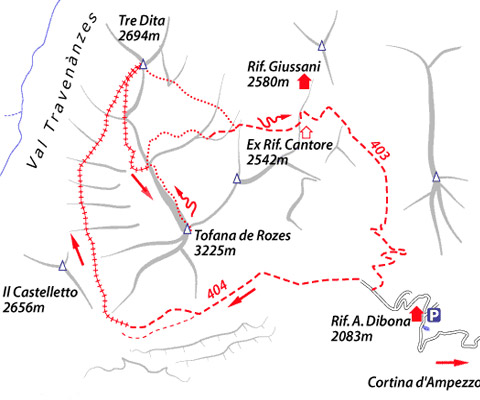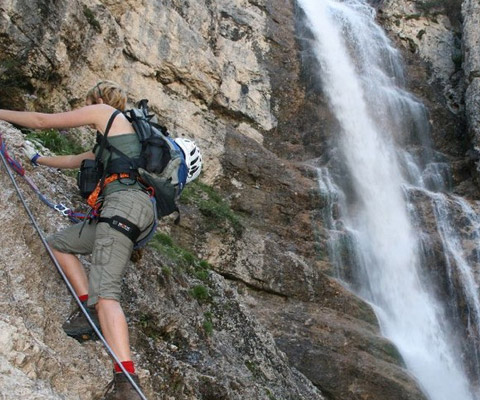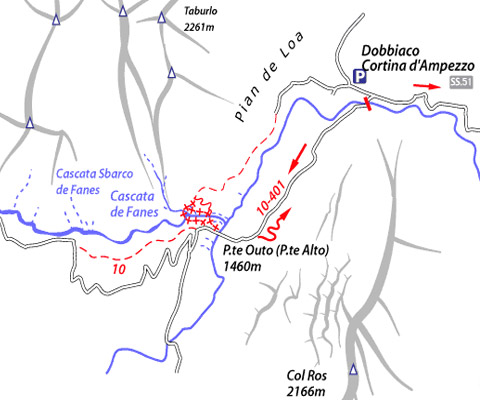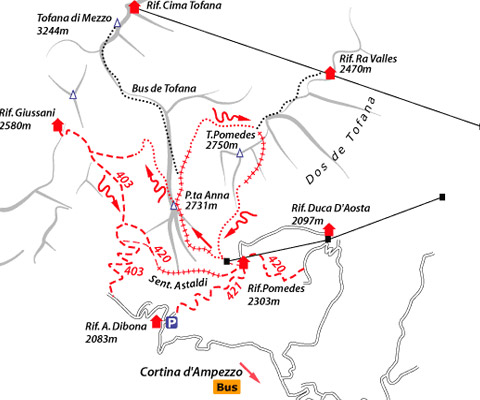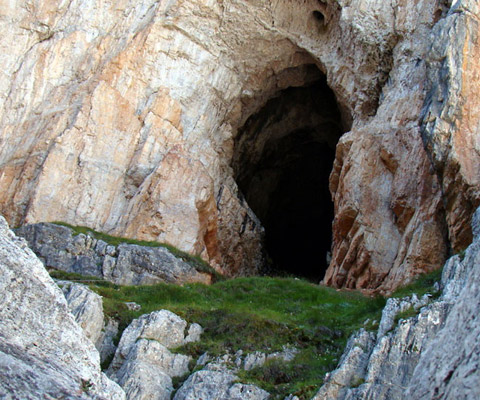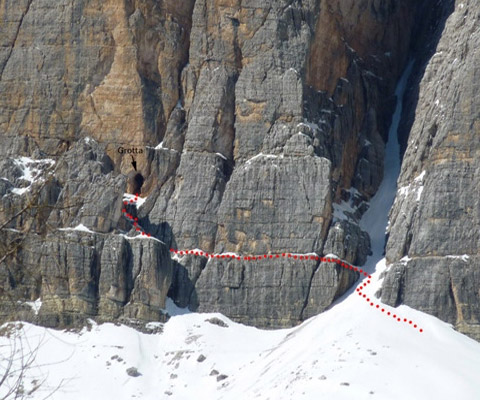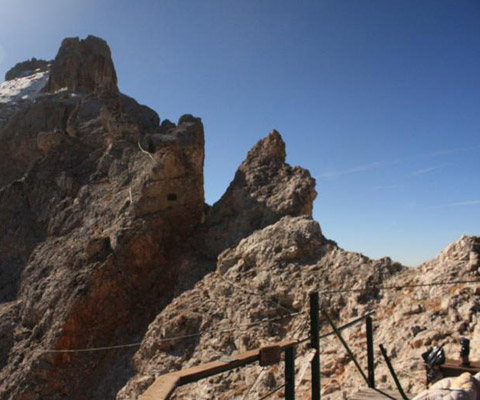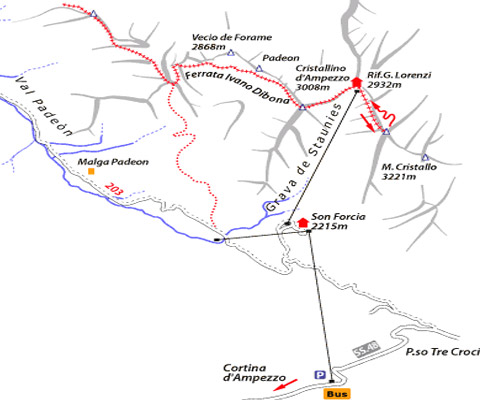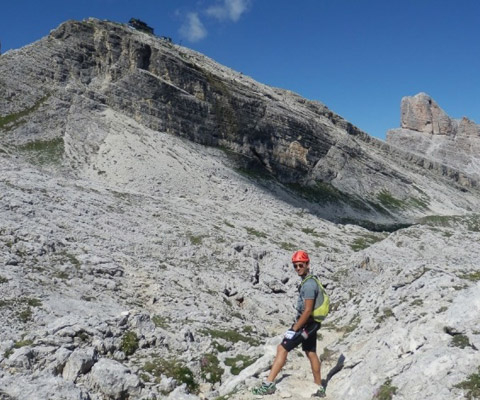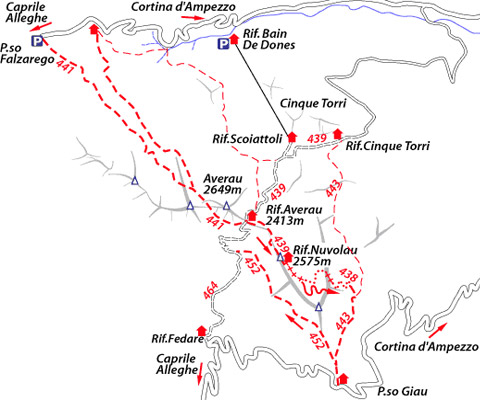Via ferrata (Italian for “iron road”, plural vie ferrate or in English via ferratas ) is a protected climbing route found in the Alps and certain other locations. The essence of a modern via ferrata is a steel cable which runs along the route and is periodically (every 3 to 10 metres (9.8 to 33 ft)) fixed to the rock. Using a via ferrata kit the climber can secure themselves to the cable, limiting any fall. In Cortina, there is a huge variety to choose from, ranging from short, relatively easy climbs to seriously challenging ones requiring a good level of physical fitness. There are 15,560 m of equipped paths and vie ferrate for you to tackle, armed with all the right equipment including carabiners and harness, but also experience and knowledge of the mountains.
Ferrata Sci Club 18
The “Sci Club 18” winds its way up the Crepe di Faloria face, immediately beneath the cable car which leads up to the top of Monte Faloria above Cortina. This difficult and exposed ferrata offers spectacular views over the entire Ampezzo basin and was created by the Cortina Mountain Guides and the Faloria company with 700m of steel cables and more than 300 pins.
Difficulty: high
Ascent height difference: 643m da Mandres
Ferrata height difference: 380m
Ferrata Ettore Bovero
This beautiful, tough ferrata crosses the exposed southwest face of the Col Rosà, the isolated rocky peak between the Tofane and Pomagagnon. Though the vertical climb (completely equipped) is short it gives the expert mountaineer immense
Difficulty: high
Ascent height difference: 900m
Ferrata height difference: 200m
Ferrata Gianni Aglio
The ferrata leads up the highest of the three Tofane. When joined to the Giuseppe Olivieri ferrata at Punta Anna (see related itinerary) it makes up a long and difficult, but highly satisfying traverse for the well-trained. Even though the route is made easier by the cable car which leads to the summit, because of its height and the possibility of bad weather it shouldn’t be taken lightly.
Difficulty: high
Ascent height difference: 800m
Ferrata height difference: 350m
Ferrata Renè de Pol
The actual via ferrata is not particularly long and traverses the north and north east faces of the Forame mountain chain, a minor western outcrop of the Cristallo group. 500m of metal cables and sections of iron rungs lead through small walls and past rubble terraces to reach the Austrian First World War emplacements and the Punta Ovest del Forame summit as well as the Forame de Fora. From Forcella Verde it is also possible to reach the Cristallo’s Forcella Grande and, along the easier Ivano Dibona, reach Forcella Staunies and Rifugio Guido Lorenzi.
Difficulty: medium
Ascent height difference: 2000m
Ferrata height difference: 300m
Gallery Piccolo Lagazuoi
This very particular remnant of the First World War is completely equipped with cables and leads through the famous winding tunnel created by the Italian soldiers. Starting from Cengia Martini they dug through the Piccolo Lagazuoi to attack the Austrian soldiers occupying the summit.
Difficulty: easy
Dislivello discesa: 350m
Ferrata height difference: 350m
Trail Ivano Dibona
This long itinerary crosses the well-known 27m suspension bridge and then follows a magnificent and airy line along ledges used during the First World War. The ferrata poses no particular difficulties as it is predominantly downhill. By combing the Ivano Dibona with the Ferrata Bianchi on the Cristallo di Mezzo and the diversion to the Cima del Cristallino one can carry out a fantastic traverse through the Gruppo del Cristallo.
Difficolta: medium
Ascent height difference: 1600m
Ferrata height difference:200m
Trail Averau
Short path near the Averau Refuge Averau. From the top of the tower, which dominates the landscape between Falzarego and Passo Giau, the look goes for a great tour of the horizon towards the Pelmo, Civetta, Antelao, Sorapis, and not lontanaTofana Rozes.
Difficulty: easy
Ascent height difference: 500m
Ferrata height difference: 100m
Terza Cengia of Pomagagnon
This beautiful excursion along Cortina’s northern Croda peaks up the third of five ledges on the Pomagagnon is in fact an airy but not particularly difficult path. Well-equipped in its most exposed sections, it traverses the mountain’s southern face from east to west in an increasingly steep diagonal line. The broad view sweeps freely and fantastically over the Ampezzo basin onto Sorapis, Croda da Lago, Tofane and remote Pelmo and Cristallo. A sight not to be missed!
Difficulty: medium
Ascent height difference: 1000m
Ascent height difference: 500m
Ferrata Albino Michielli Strobel
The “Strobel” is a classic and highly popular via ferrata that takes a logical line up wide ledges through the west face of the Punta Fiames, past exposed but well-equipped sections. The view onto Cortina and the Boite valley is unequalled. Despite its relative closeness to Cortina, the considerable height difference makes good fitness an essential pre-requisite.
Difficulty: medium
Ascent height difference: 1000m
Ferrata height difference: 600m
Ferrata Formenton
The Ferrata Formenton is in fact a beautiful traverse that starts from the summit of Tofana di Mezzo, which is reached via cable car. By ascending the Tofana di Mezzo’s south face one can access the less visited Tofana di Dentro, before descending along the north ridge to the Ra Valles cable car station. A complete and demanding circuit can be made by combining this ferrata with the Ferrata G. Aglio on Tofana di Mezzo.
Difficulty: medium
Ascent height difference: 220m
Ferrata height difference: 400m
Ferrata Giovanni Lipella
The ‘Lipella’ high up on the Tofana di Rozes is an unmissable ferrata for any keen mountaineer. A splendid journey into the heart of the Dolomites and a trip into history where the most tragic and memorable events of the First World War took place. The length of this ferrata makes it tough. Equipped in the most difficult parts, it picks out weak points of the south west face where it follows a lengthy route up stepped terrain and scree-covered ledges, up to the 3225 meter peak.
Difficulty: medium
Ascent height difference: 900m
Ferrata height difference: 600m
Ferrata Giovanni Barbara
This is a very interesting and easy roundtrip, well equipped with cables wherever necessary. Acting as an excellent entry from Cortina to the splendid Valle di Fanes, the ferrata can be carried out in a gentle half day outing. The walk takes you across an enchanting countryside as the forest green contrasts strikingly with the steep Taè south face and the grey Col Bechei limestone. This walk and ferrata is above all a trip along the gushing river Rio di Fanes and its splendid waterfalls. The section beneath the first fall is unique and not to be missed under any circumstances.
Difficulty: easy
Ascent height difference: 200m
Ferrata height difference: 100m
Ferrata Giuseppe Olivieri
This ascent, almost entirely equipped with cables, follows the steep southern arête up Punta Anna, the large outcrop that looks onto the Tofana di Mezzo. Without a doubt one of the most interesting and beautiful via ferrata in the Dolomites, its steepness, exposure and beauty render it immensely satisfying, and the view onto the imposing south face of the Tofana di Rozes is unforgettable. The ferrata can be extended by combining it with others close by, including the ascent of the Tofana di Mezzo.
Difficulty: high
Ascent height difference: 648m
Ferrata height difference: 440m
Ferrata Grotta of Tofana
The cave is in the Tofana Rozes and is one of the few cavities that are formed in the Main Dolomite and not in Limestone. Short trip worthy of interest, especially during the spring when the cave is filled with ice stalagmites. The cave takes on a fairy-tale, stretches spiral for about 300m and turn is 10m high at most.
Difficulty: bassa
Ferrata Marino Bianchi
This short but panoramic itinerary follows the crest which, at 3000m, runs from Forcella Staunies to the summit of Cristallo di Mezzo. Equipped with cables and ladders, the highly popular “Marino Bianchi” is ascended and descended along the same line.
Difficulty: medium
Ascent height difference: 480m
Ferrata height difference: 240m
Ferrata Ra Gusela
A new, short via ferrata which replaces the original one along the gully which is now closed for safety. The via ferrata runs along the southeast face and is normally undertaken in descent leaving from Rifugio Nuvolau. This is reached via path no. 439, along the wide ramp of the northwest crest.
Difficulty: medium
Ascent height difference: 540m
Ferrata height difference: 350m
 English
English Italiano
Italiano
